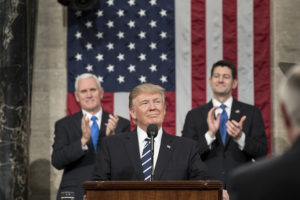
Flanked by Vice President Mike Pence and Speaker of the House Paul Ryan, President Donald Trump delivers his Joint Address to Congress at the U.S. Capitol Building in Washington, D.C., Tuesday, February 28, 2017. (Official White House Photo by Shealah Craighead)
At CBS News, Michael Graham, a conservative columnist for the Boston Herald, explains why, despite incessant negative media coverage of President Trump, his approval ratings continue to rise on average. He writes of America’s jobs champion (abridged):
On Labor Day 2017, the polls were dismal for President Trump — according to Real Clear Politics, his average approval rating was 38.5 percent.
But after a year of Robert Mueller investigation headlines, porn-star payoffs and strange Twitter rants, Trump’s numbers are…up: 42 percent.
A year of virtually non-stop negative media attacks and self-inflicted political wounds, and the president is more popular? How does that happen? To quote Joe Biden from the 2008 campaign trail, “It all comes down to one three-letter word: ‘Jobs.'”
In part because Trump’s job growth is different. President Trump campaigned in the Rust Belt and told men—in particular, blue-collar, non-college-degree-holding men—that their economic future could be brighter, too.
After years of talk about the benefits of globalism and new technology for white-collar Americans, Trump told the “forgotten Americans” they would be forgotten no more, and to a degree, he’s kept that promise.
The top two sectors of job growth under Trump: not financial analysts or college administrators, but the mining and logging industry (up 13.5 percent since the election), along with construction and transportation. In fact, growth in manufacturing jobs over the past year was greater than at any time since 1995. Blue-collar work for blue-collar skills and blue-collar guys.
This comes after years of being told by Washington elites and the media that their way of life was obsolete, that the people J.D. Vance wrote so eloquently about in “Hillbilly Elegy” had no future. Then Trump shows up, tells them they have reason to hope, and jobs—their kind of jobs—follow. Is it any surprise those workers and their families are sticking with Trump?
And then there’s the way President Trump talks about jobs and the economy. His current NAFTA fight is a perfect example of how Trump frames the jobs conversation in terms of these traditional laborers, as opposed to the broad, positive impact of increased trade. North America is essentially a $1 trillion trade zone. Much of that trade involves the white-collar economy and high-tech jobs. But when Trump talks, his focus is manufacturing jobs. He’s demanding increases in the content in cars that must be made by American workers, putting pressure to raise wages from the low end in Mexico to make American wage earners more competitive.
These are relatively small changes on what, in the big picture, is a tiny part of our international trade. But when these families hear Trump taking on Canada, Mexico and China over trade, they hear him taking on the world for them.
Read more here.
If you’re willing to fight for Main Street America, click here to sign up for my free weekly email.




